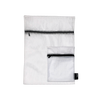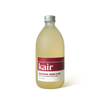To dry clean or not to dry clean
So, the care label on your new clothes says “dry clean only”, but how can you tell whether that really means dry clean only? The short answer is that it’s mostly a case of sneaky back-covering: manufacturers often do not machine-test clothes, which means that if you wash a dry clean only item by any means other than dry cleaning and it gets damaged, you can’t hold them responsible. Or, much of the time, the garments can be safely washed - just not with a harsh detergent and at high temperatures, which can cause shrinkage and discolouration. That’s why manufacturers default to dry clean only, rather than specifying gentle detergent and cold wash. So when is it a recommendation, and when is it a must? Read on to find out.
Dry clean always items
When it comes to caring for clothes with a dry clean only label, there are a select few fabrics which must always be dry cleaned. This is both to protect them against the effect of water and/or heat, and to remove stains like grease and oil which can’t be removed by a traditional ‘wet’ cleaning process. These are vulnerable to losing their lustre and texture if washed without professional care, especially if they have special finishes which may come off if washed in water. It’s important to not risk washing these items at home, especially if they’re labelled as such.
Aside from these materials, while fabrication is important, it’s primarily garment construction and embellishment which inform “dry clean” advice. Avoid washing the following at home:
To preserve the lifespan of dry clean only pieces, avoid washing after every wear. This is especially the case with garments which don’t touch the skin. We recommend washing once a season or as few times as possible, unless the item is heavily soiled. You can also spot treat stains, and freshen up with finishing spray, to save on trips to the dry cleaner.
Dry clean never items
Before the days of dry cleaning, when everyone’s clothes were made out of cotton, linen, wool or silk, whether to wash at home or not wasn’t even a question - as Sandra Tullio-Pow, associate professor of fashion at Ryerson University, observes. Only around 10% of dry clean only clothing truly falls into the dry clean only category. The rest of your wardrobe need not wither away within the wicker until a trip to the dry cleaner. In the vast majority of cases, it’s not only possible to wash dry clean only clothing at home, but actually much better than going to the dry cleaner, which involves exposure to a destructive substance known as tetrachloroethylene (a.k.a. PERC), a neurotoxin associated with profound social and environmental hazards.
The chemical cocktail of the dry cleaner can cause irreparable damage to the clothing fibres too, breaking them down and altering the shape of the garment. Washing natural wool and wool blends is a classic example: dry cleaning can flatten the yarns and make them dull, while also often failing to remove odour or stains. Washing wool not only preserves and stimulates the natural oils, or lanolin, in the yarns themselves, it also gives the garment as a whole a naturally fresh look and feel (check out our ultimate guide to mastering the wool wash).
To help you decide whether or not to dry clean your garment, we’ve compiled a handy list of fabrics suitable for washing at home, whether by hand or by machine:
Spot test
If you’re planning on washing any delicate pieces at home, it’s still important to always take precautionary measures. Performing a simple spot test is an easy way to check. Dab a very small amount of water and/or detergent on an inconspicuous area of fabric. If this leaves marks, or causes discolouration, ripples or wrinkles, we would strongly advise against continuing.
Be gentle
Whether you’re machine or hand washing dry clean only clothes at home, remember the word gentle: gentle detergents and conditioners; gentle heat and gentle cycle. That means choosing a made-for-delicates detergent like our specialist Wool, Silk and Delicates Wash, cool temperatures (no higher than 30ºC), and a cycle using the least amount of agitation possible.
If you’re machine washing, always use a mesh laundry bag, to give your clothes an extra layer of protection inside the drum. Show your pieces tender, loving, Kair if you’re hand washing as well. That means no scrubbing or wringing, which can cause the fibres to stiffen and change shape. And avoid tumble dryers and radiators at all costs. Hang or lay flat to air dry naturally.
There’s no need to feel anxious about ruining your expensive dry clean only items at home. As long as you stick to our advice, you can wash with confidence and wear carefree.
Cover Image by Joseph Molines for Isabel Marant


















